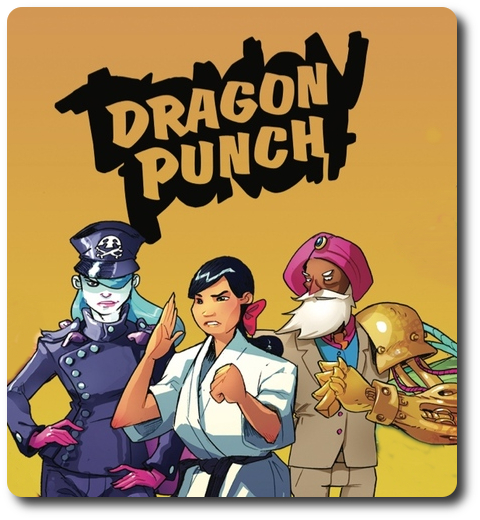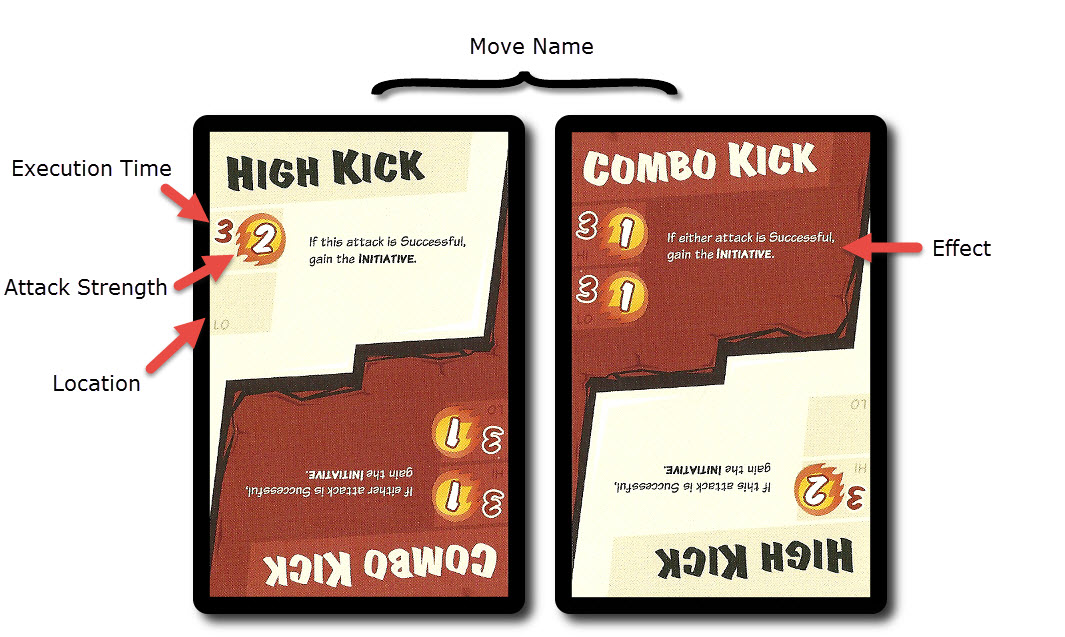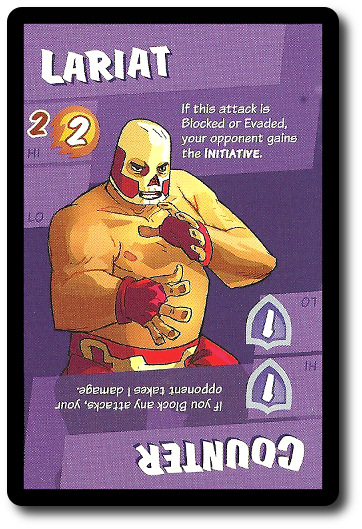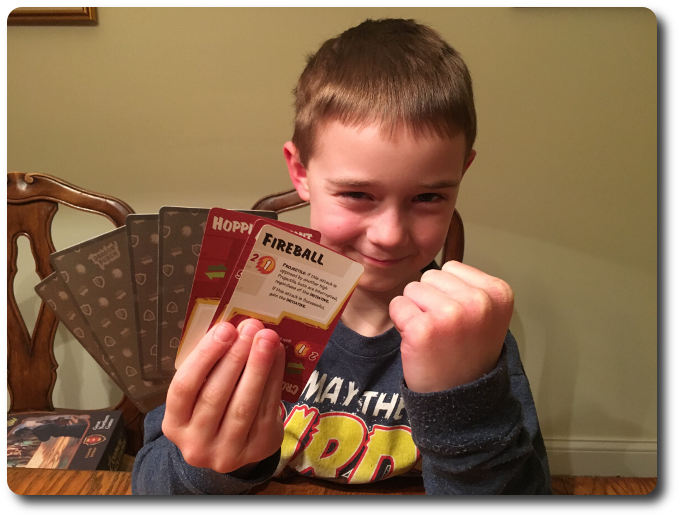
The Basics:
- For ages 8 and up (publisher suggests 12+
- For 2 players
- Approximately 15 minutes to complete
Geek Skills:
- Active Listening & Communication
- Counting & Math
- Logical & Critical Decision Making
- Reading
- Hand/Resource Management
Learning Curve:
- Child – Easy
- Adult – Easy
Theme & Narrative:
- A warrior must be brave at heart, strong of body, and quick of mind
Endorsements:
- Gamer Geek mixed!
- Parent Geek approved!
- Child Geek approved!
Overview
You have practiced for years under the strict tutelage of your Master. Having progressed far enough to test your skills against other warriors, you enter an underground martial arts tournament. There you will battle against the greatest fighters. This is a test you must take. Succeed and you have completed your training. Fail and you have failed your Master.
Dragon Punch, designed by Koen Hendrix and published by Level 99 Games, is comprised of 12 Basic cards, and 5 Character cards. The cards are as thick and as durable as your standard playing card. Worth mentioning, only because I think it’s pretty neat, the game includes a slim trifold wallet that holds all the cards and makes the game very portable.
Game Set Up
To set up the game, give each player a complete set of 6 Basic cards. No player should have duplicates of the same Basic card in their hand. After the cards are dealt, each player should organize their hand so the white portion of the Basic card is at top.
Second, either shuffle and randomly deal 1 Character card to each player or allow each player to pick the Character card of their choice. The selected Character card is added to the player’s hand of cards. Orientation of the Character card is not important at this point in the game. Any Character cards not selected are out for the duration of the game.
That’s it for game set up. Let’s fight!
Dojo Basics
Dragon Punch is a fast game depicting swift punches and powerful kicks. It’s important that a player know how to use the Basic cards and the moves they represent, as well as the special moves known only by their Character, if they are to win.
Basic Cards
The Basic cards list 2 types of moves. The first is in white which is available to the player until they get hurt. Once the player takes damage during the fight, the player can use the moves in red. Next to each move is a Hi and Low box that determines where the attack is aimed. The attacks themselves will have text that describes them, as well as rule changes. Finally, symbols and numbers are used to represent if the move is an Attack or it provides Defense and Evade. These are used when resolving combat.

Not all Basic cards provide moves that can protect the Character and not all moves can attack the player’s foe
Character Cards
Character cards are used the same way as the Basic cards, but are unique to the player and either the top or bottom portion of the card can be used at anytime.

Fist, Meet Face
Dragon Punch is played in turns with no set number of turns per game. Each turn is comprised of 4 sequential steps.
Step 1: Select One Card
Each player simultaneously selects 1 of their cards that is facing them in their hand. The selected card is removed and the hand of cards is collapsed (no longer displayed like a fan). The selected card is placed at the back of the hand. The player then places their hand of collapsed cards down so the selected card is at the top. This informs the player’s opponent that they are ready to move to the next step.
Step 2: Resolve Cards
On the count of 3, each player flips over their selected card. For added thematic awesome, shout the name of the move, which is fun, but not at all necessary. At the very least, orientate the card so the correct move is facing the player who is using the card.
First, both players inspect their selected cards for Attack strength, Block strength, and Evade strength in the Hi and Lo locations. If an attack is blocked or evaded by an opposing move, wherein the Attack icon and the Block or Evade icon are in the same location, the attack is deflected.
If only 1 player made an attack that was not blocked or evaded, it’s considered successful and the Attack strength value is the damage inflicted on the player’s opponent’s Character.
If both players make a successful attack, only the fastest hit, regardless of the location of the attack. The fastest attack is determined by reviewing 3 conditions.
- If 1 player has the initiative, their attack is successful.
- If no player has the initiative, the player with the lowest Execution Time for the attack is successful.
- If both players attack all have the same Execution Time, both attacks are successful.
Some cards might have text that adjusts the way in which the cards are resolved. In all cases, review the text to ensure the card is being resolved correctly.
Step 2: Taking Damage
The health of a Character is tracked by the Basic cards. Every white-side up Basic card in the player’s hand is 1 Health Point. When a Character takes damage, they rotate a number of cards equal to the damage taken so that the red-side is at top.
Rotating a Basic card from white to red changes the move. In many respects, a damaged Character is a more dangerous foe. Before a player rotates their cards to account for damage, they should carefully consider if it’s more advantageous to rotate one card versus another.
If a player is unable to rotate a card to account for damage or rotates their last white-side card, the Character’s Health is reduced to zero and the player loses the round.
Step 3: Flip Used Cards
After damage has been accounted for, both players must take the card they used and flip it so it’s facing their opponent when their opponent looks at the player’s hand. This card is no longer usable until the player uses their “Taunt” Basic card to flip all their cards back. The most recent flipped card should be visible to the opponent, but any past flipped cards can be covered over or blatantly hidden as long as they remain in the player’s hand and facing the opponent.
When flipping cards back after using the “Taunt” Basic card, make certain to keep the cards rotated the right way. That is, do not rotate red-side cards to the white-side.
Step 4: Assign Initiative
At the start of every round, no player has the inattentive and the Execution Time of a specific move determines which Character hits first. After the first turn of the round, initiative can be given to a player based on the Basic card they use. Some Basic cards will award the player initiative on a successful attack or block. Being granted initiative only lasts a single turn, regardless if it’s used or not during combat to break ties.
End of the Round and Winning the Game
The round comes to an end when 1 Character has lost all their Health Points. The round is then reset with both players collecting their Basic cards and rotating them to the white-side facing towards the top of the player’s hand.
The game ends as soon as 1 player has won 2 rounds.
Game Variants
There are a number of game variants included that can be used by those players looking to change or to make things tougher.
Tag Team
Each player selects 2 Character cards before the game begins. Mix and match the Character abilities to create interesting combos and assists.
Turbo Mode
This game variant doesn’t give the player much time to think about what they should do. One player says, “1, 2, 3, FIGHT!”. On the command word “FIGHT!”, each player slams down their selected card for the turn. The turn is then resolved as normal.
Customized Combatants
If 2 or more copies of the game are available, allow the players to select the 6 Basic cards they want to use. This gives each player an opportunity to include 2 or more Basic cards of the same type in their hand, customizing their Character’s fighting technique. No more than 6 cards can be selected.
To learn more about Dragon Punch, visit the game publisher’s website.
Final Word
The Child Geeks caught right on, but had some initial trouble with the card facing. While they all understood that the red was bad, they didn’t understand the tactical benefits of rotating one card versus another. Nor did they immediately grasp what good it was to be able to see some of the opponent’s cards. According to one Child Geek, “I know I’m supposed to learn something and there is a reason why I am allowed to select a card, but I’m not seeing it.” After a few games, they did, and the cards rotated, flipped, and flung were all part of the Child Geeks’ strategy to get in close and pummel the snot out of their opponent. As one Child Geek put it, “This game is a lot of fun. The biggest challenge is attempting to out think your opponent, but you will have to take a few punches yourself.” When the games were over, the Child Geeks all agreed that Dragon Punch was a good time.

The look of confidence in his eyes is intimidating…
The Parent Geeks were less enthused about the game, but enjoyed it all the same. For them, the fun came from managing their cards and attempting to out punch their opponent one fist at a time. According to one Parent Geek, “This isn’t a game you have to put a lot of thought into, but you need to try to play your cards smart. It’s light and quick, so even a bad play is quickly forgotten.” Which is to say, Dragon Punch will punch the player if they don’t put a little bit of thought into their actions, but a bad choice does not leave a sting. Another Parent Geek said, “This game reminds me of those video games I played at the arcade and at home. I like how you have to pick not only your card, but where you are punching.” With a good mix of defensive and offensive abilities, the Parent Geeks all voted to approve the game.
The Gamer Geeks were mixed when it came to their approval. One half of the Gamer Geeks found Dragon Punch to be a light game that had just enough strategy and tactics, risk versus reward, and hand management to elevate the game to a solid filler. According to one Gamer Geek, “The game has depth, despite how light it feels. Players get to make meaningful choices, are forced to think ahead, and can take tactical actions. I like it.” The other half found Dragon Punch to be little more than War with a few tricks and traps thrown in to make it feel like a game of substance. According to one of these Gamer Geeks, “You can play this game by just tossing cards down at random and it won’t matter, selection of which card to rotate or not doesn’t matter, and any information you get from your opponent ultimately doesn’t matter. This game would be great for kids, but any serious gamer wouldn’t think twice about playing this.” Harsh words from a harsh critic. Despite the different opinions, Dragon Punch escaped a killing blow and was given a mixed approval by the Gamer Geeks.
Dragon Punch is small, easy to learn, easy to play, and makes no attempt to declare itself as anything other than what it is. This is a tiny fighting game that can be played anywhere. A table works best, but is by no means necessary. The game play is intuitive, but manages to avoid being boring or repetitive thanks to the player’s ability to change different Characters and adjust their Basic card moves. Even the way players keep track of damage and rounds is deftly done, so as to give players the ability to focus on the fun of the game with minimal effort. I’m very pleased.
Card counters will have difficulty attempting to get the upper hand since cards can be rotated from white to red. Not only would someone have to remember the card, but also its orientation. Seeing what cards were played helps a great deal, but information is quickly hidden due to new cards overlapping old ones. The end result is a game that gives a player just enough information to make a reasonably informed decision, but not enough to know with absolute certainty. Only when the cards are flipped over and revealed do players learn if their instinct, intuition, and critical thinking were correct. Creates just enough tension and excitement to make every reveal of the cards a moment of anticipation.
One of our players mentioned that Dragon Punch reminded them of War. I think that’s like saying “cake reminds me of pie”. There are similarities, but they are so few in number that I cannot agree with their statement. Dragon Punch has a system that quickly resolves combat, but there are a number of ways to duck, dodge, and counter. Players can even improve attacks and adjust based on new information. This is not a game where simple values are compared, but nor is it much more than that, either. Combat is swift and the victor is easily spotted, but this is only the result. The meta game between players, the deduction, hand management, and bluffing comes first.
I have always enjoyed small games that take little time to learn, little time to play, and provide a bigger gaming experience than their size would suggest. Dragon Punch is such a game. Small in stature, big on fun. It’s not a game you will play as the main event, but it’s a game you can play with anyone. Not a perfect game by any means, but a perfect game to play anywhere. If you are looking for a game that makes you think, makes you smile, and can fit in your pocket, do take a look at Dragon Punch. It’s upper cut will leave you smiling.
This game was given to Father Geek as a review copy. Father Geek was not paid, bribed, wined, dined, or threatened in vain hopes of influencing this review. Such is the statuesque and legendary integrity of Father Geek.



